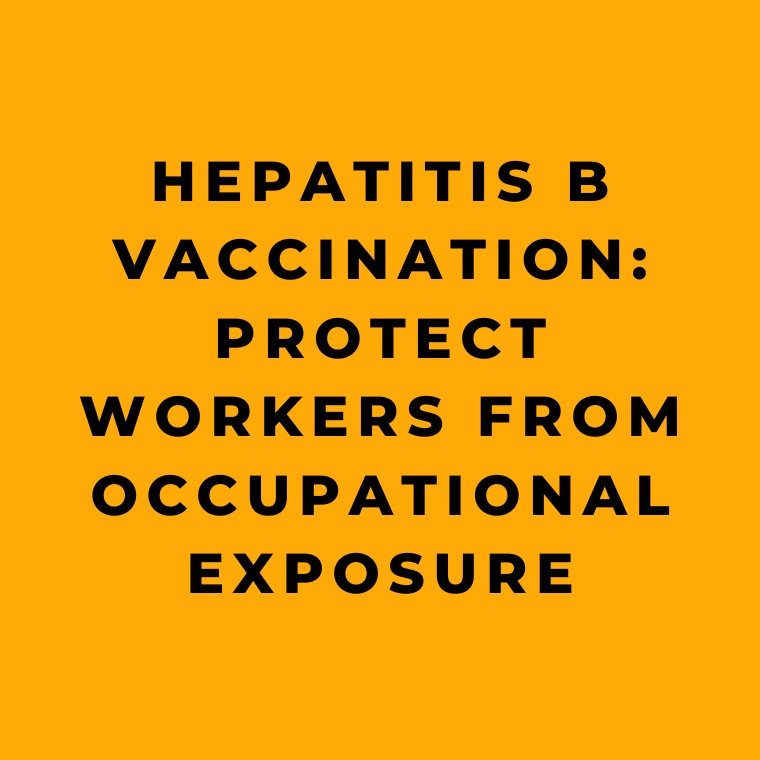Hepatitis B Immunization Protection Hepatitis B virus (HBV) is a harmful microorganism that can cause potentially life-threatening diseases in humans. HBV infection is transmitted through contact with blood and other potentially infectious materials (OPIM), as defined by OSHA’s Bloodborne Pathogens standard, 29 CFR 1910.1030.
Workers who may come into contact with blood or OPIM during their job duties are considered to have occupational exposure and are at risk of infection. Those infected with HBV face the risk of developing severe liver conditions, including cirrhosis and primary liver cancer, which can be fatal. A small percentage of adults who contract hepatitis B never fully recover and remain chronically infected. Moreover, infected individuals can transmit the virus to others through contact with their blood and other bodily fluids.
Employers must create an exposure control plan and implement universal precautions and control measures, such as engineering controls, work practice controls, and personal protective equipment, to safeguard all workers with occupational exposure. Additionally, employers must provide hepatitis B vaccinations to these workers. Hepatitis B vaccination is acknowledged as an effective means of protection against HBV infection.
HBV Immunization The standard mandates employers to offer vaccination series to all workers who have occupational exposure. Examples of workers who may have occupational exposure include, but are not limited to, healthcare workers, emergency responders, morticians, first-aid personnel, correctional officers, and laundry workers in hospitals and commercial laundries servicing healthcare or public safety institutions. The vaccine and vaccination must be provided at no cost to the worker and at a reasonable time and place.
The hepatitis B vaccination is a non-infectious vaccine produced from recombinant yeast cultures instead of human blood or plasma. There is no risk of contamination from other bloodborne pathogens, nor is there any chance of developing HBV from the vaccine.
The vaccine must be administered following the U.S. Public Health Service (USPHS) recommendations current at the time the procedure is performed. To ensure immunity, individuals must complete the entire course of vaccination outlined in the USPHS recommendations.
The vast majority of vaccinated individuals will develop immunity to the hepatitis B virus. The vaccine poses no harm to those already immune or to those who may be HBV carriers. Although workers may want their blood tested for antibodies to determine if vaccination is necessary, employers cannot make such screening a condition for receiving vaccination, and employers are not required to provide prescreening.
Employers must guarantee that all occupationally exposed workers receive training about the vaccine and vaccination, including its efficacy, safety, administration method, and vaccination benefits. They must also be informed that the vaccine and vaccination are provided at no cost to the worker. The vaccination must be offered after the worker receives training and within 10 days of being initially assigned to a job where there is occupational exposure, unless the worker has previously received the vaccine series, antibody testing has shown the worker to be immune, or the vaccine is medically contraindicated. The employer must obtain a written opinion from the licensed healthcare professional within 15 days of completing the vaccination evaluation. This written opinion is limited to whether hepatitis B vaccination is indicated for the worker and if the worker has received the vaccination.
Refusing the Vaccination Employers must ensure that workers who decline vaccination sign a declination form. The purpose of this form is to encourage greater participation in the vaccination program by stating that a worker declining the vaccination remains at risk of acquiring hepatitis B. The form also states that if a worker initially declines the vaccine but later decides to accept it, the employer must make it available at no cost, provided the worker is still occupationally exposed.
Additional Resources For more information, visit OSHA’s Bloodborne Pathogens and Needlestick Prevention Safety and Health Topics web page at:
https://www.osha.gov/bloodborne-pathogens
To file a complaint by phone, report an emergency, or seek OSHA advice, assistance, or products, contact your nearest OSHA office under the “U.S. Department of Labor” listing in your phone book, or call them toll-free at (800) 321-OSHA (6742).
References:










